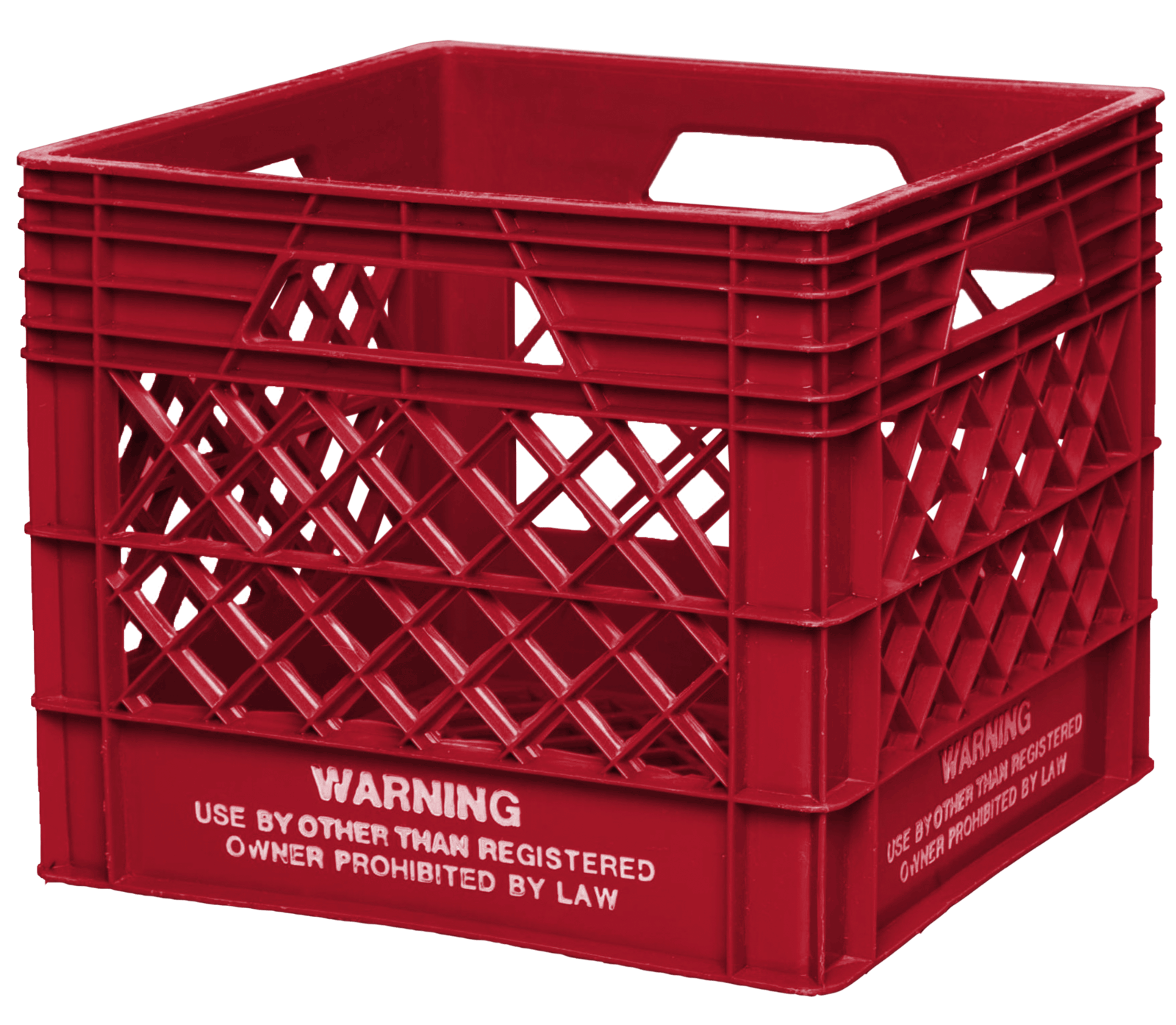Today in Tedium: Sometimes, it’s possible to create something that’s too useful, that is designed for a niche purpose but is so well-attuned to that purpose that it attracts other people, who find a similar value but different use case than was intended. And because of the sheer prevalence of said useful tool, it suddenly is everywhere—finding purpose as a cheap alternative to a trip to the local department store. If you’re the maker of that too-useful something, whaddya do? Well, in the case of the dairy industry, you use your political influence to try to ban all those college students from using milk crates. In today’s Tedium, we talk about the bizarre legal status of the plastic milk crate. — Ernie @ Tedium
“I don’t see the artistic merit even now. It was purely utilitarian.”
— Geoff Milton, an Australian designer and engineer who has been credited with inventing the modern plastic milk crate in the 1950s and 1960s, speaking to The Sydney Morning Herald back in 2014. (Milton was pulled into the public sphere thanks to a debate over a piece of art that was effectively a gigantic milk crate, which he was understandably skeptical about.) Milton’s design has larger holes than the prevailing design used in the U.S.—something he said was done out of desire to discourage use of the crates for reasons other than milk. Another early claimant to the invention is the American Rehrig Pacific Company, which was working on plastic-based crate designs during the same period and patented an injection-molded crate that closely matches the most common American design back in 1968.
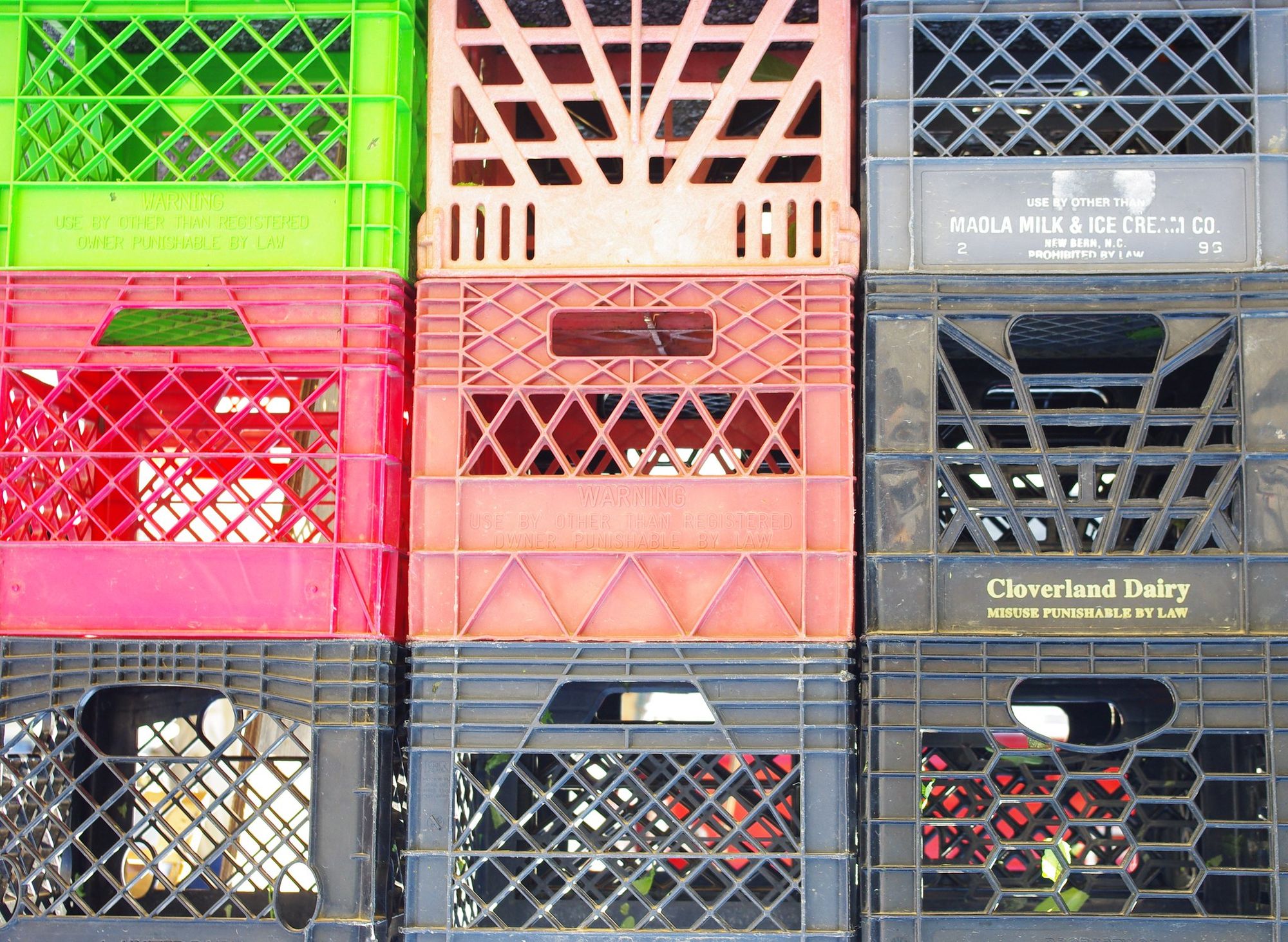
Why everything that makes the plastic milk crate great for milk also makes it great for everything else
Before I get into milk crates, I want to talk about something that’s made of plastic, and that’s also accidentally perfect for milk crates: The vinyl record.
A vinyl record has a specific size—it’s about 12 inches round, and when placed inside of an often visually welcoming sleeve, it’s about 12 inches square. It’s a simple design, and though it’s fairly large and perhaps more difficult to carry around than your average iPod, it is very stackable.
So you have this thing that’s 12 inches square, flat, and stackable. Its size has at times been a point of contention—just ask record stores, which were so accustomed to this size that they literally created giant boxes for CDs to go in just so they could continue to use their old record trays—but there are a lot of them around.
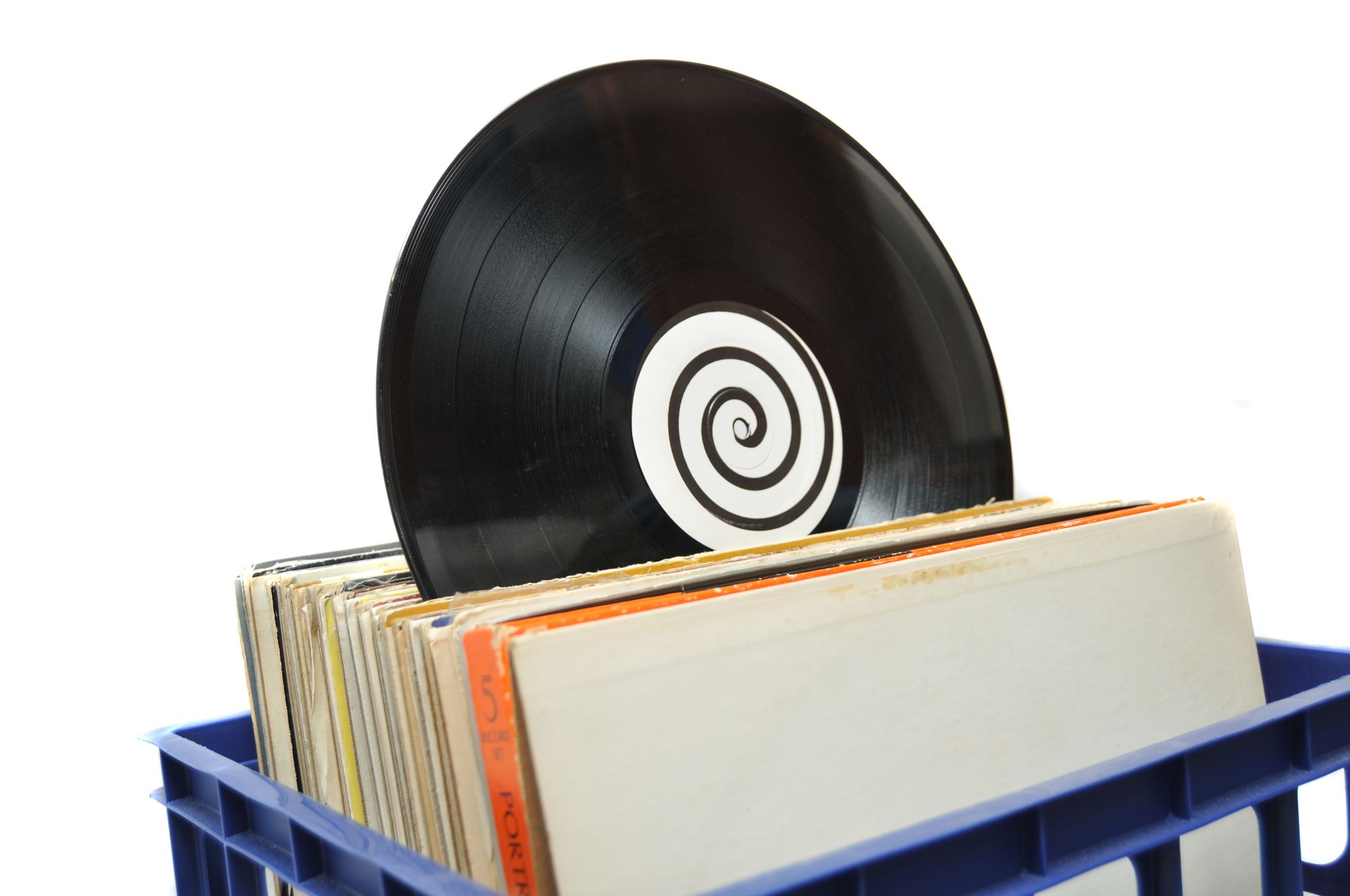
If one didn’t know better, you might think that the milk crate—which typically is between 12 and 13 inches wide and 10 and a half to 11 inches high, with plastic that at its thickest point is maybe a quarter-inch wide—was designed for vinyl records. It wasn’t. The fact that milk crates are the perfect size for wading through a bunch of albums was a happy accident.
Of course, the dairy industry probably wasn’t thinking about that in the late 1960s and early 1970s, when the plastic milk crate first went into wide use. They, likely, were instead thinking about the dimensions of milk containers, which roughly are proportional in size and weight. Let me go over a couple of the most common sizes real quick:
Your average gallon of milk, which in the U.S. generally comes in a plastic container with a handle and probably weighs as much as a bowling ball, is about 10 inches tall, and 5.625 inches wide. About four of them can fit in a standard milk crate.
Your average half-gallon of milk, meanwhile, is about the same height as a gallon of milk, but 3.5 inches wide. About nine of them can fit inside a standard milk crate.
A quart of milk, often sold in paper containers rather than plastic ones, has a footprint of about 2.7 inches in width, give or take. About 16 of those can fit inside a standard milk crate.
And a half pint, a tiny 8-ounce carton that you might see at a school as a delivery vessel for individual-sized milk, is about the same width as a quart case, but has more of a stout size (about 3.25 inches high, with maybe about a quarter of an inch made up of the paper seal), allowing for a number of them to be stacked on top of one another, with one row upside down and one row right-side up. By my best estimate—numbers are a little hazier with this one than the others—you could probably fit about 64 of them inside of a milk crate.
To put it all another way, the plastic milk crate—with a design that allowed a lot of different, somewhat modular sizes of milk containers to fit into a single case—worked really well for milk. And the crate had other benefits, too: The exterior was built in a way that allowed for inter-locking, which made the crates easy to stack and put next to a bunch of other stacks of milk, and the plastic was often quite thick and of high quality, which made it a great vessel for reuse.
Especially when it wasn’t the milk company that was actually reusing it.
“Unauthorized use of milk cases illegal; fine of $300 or imprisonment up to 90 days, Pennsylvania Law Act No. 37, 1987.”
— An example of the kind of warning seen on milk crates in the U.S. A 2013 piece by Modern Farmer makes the case that theft of these crates is semi-organized and costs tens of millions per year—a lot, when it comes to milk, due to the margins. Milk currently goes for $15.98 per hundredweight, or per 100 pounds, according to the U.S. Department of Agriculture—so a cost of just below 16 cents per pound. However, high-density polyethylene (HDPE), the material used to make plastic milk crates, went for 33 cents per pound as of last November, the last period I could find—meaning that the plastic is actually more valuable on the black market than the milk if it can be acquired in bulk and converted back into scrap. It’ll probably last longer than the milk, for one thing.
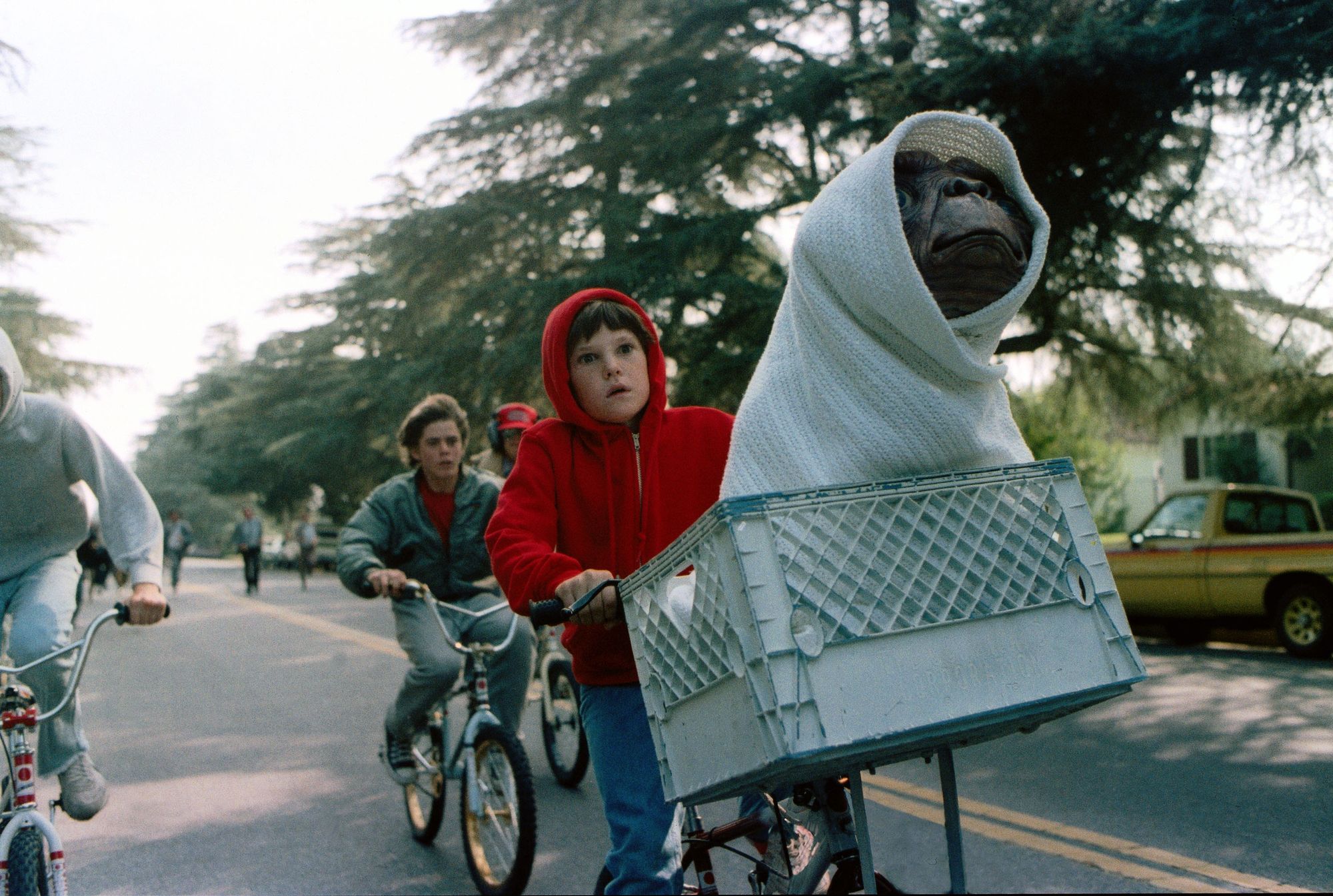
I sure hope Elliott didn’t steal that milk crate E.T. is sitting in. A guy got arrested a couple years ago for doing something similar. (Amblin Entertainment)
How laws barring the use of milk crates came to life, and why those laws are extremely problematic
Now, there’s something that needs to be made clear about the dairy industry that makes it a bit different, from, say, the technology industry or a traditional manufacturer: It gets a lot of support from the federal government in the form of subsidies.
Like the beef industry, which has gotten a lot of fine cuts out of its checkoff program, the dairy industry has a lot of clout, both in the form of checkoff programs of its own, and through its use of large organizational bodies that are organized and have a lot of political clout. Hundreds of millions of people drink milk or rely on products that use it—it makes sense that those that produce it are politically powerful.
That power highlights itself in interesting ways. Remember this “Got Milk?” commercial featuring the historian whose peanut butter sandwich got in the way of winning a radio contest? That was all the dairy industry—which successfully got a good commercial out of Michael Bay just before he spent the next quarter-century making complete junk.
Now, mentioning “Got Milk?” is actually pretty notable in this context, because the dairy industry actually runs a site called “Got Milk Crates?”—which highlights an industry line on crates: If you put one in your living room, you’re not reusing it, you’re requiring the dairy industry to make another one.
“Each milk crate makes thousands of trips to and from stores with some lasting more than 20 years,” the site states. “They are very sustainable packaging when they are allowed to do their job and not removed from the milk delivery system for other ‘duties as assigned.’”
But the milk industry has never entirely relied on public relations campaigns to make this point. In 1987, it convinced the Pennsylvania state legislature to make a different kind of case for them: A law passed in the state that year, with the backing of the Pennsylvania Milk Dealers Association, literally made possessing a milk crate labeled with the owner’s name a crime—along with possessing similar types of containers, such as shopping carts and laundry carts. The punishment? A $300 fine—or up to 90 days in jail.
(I can only imagine the prison conversation the guy who pulled off the mattress tags had with the guy who stole the milk crates.)
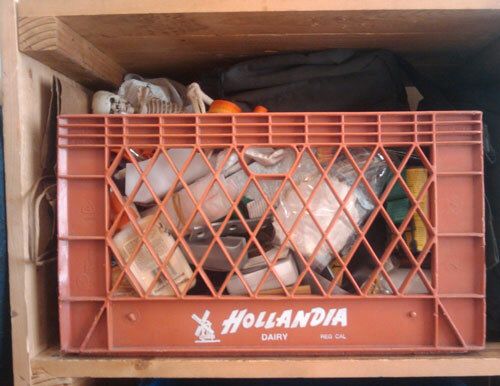
The dairy industry frowns upon this. (ArielGlenn/Wikimedia Commons)
But why? Well, simply put, the crates are of a particularly high quality, and aren’t cheap to make. And as a result, when crates go out of circulation, they cost a lot of money to replace—at scale, millions per year—and that, unwittingly, affects the price of milk.
“We don’t want to see anyone go to jail or pay a $300 fine,” said Bill Cramsey, the owner of a dairy distributor, in a 1987 article in The (Allentown, Pennsylvania) Morning Call. “All we want is our milk crates back.”
The Pennsylvania law was first, but other states followed suit—among them Virginia, where it’s a fourth-degree misdemeanor to buy, sell, or dispose of a milk crate, and Florida, where it’s a first-degree misdemeanor to possess one.
The severity of these laws compared to the offense, of course, leave a lot of room for abuse. One such case in Florida, as highlighted by Reason in 2016, involved a man who found a milk crate on the side of the road, attached it to his bike, and was arrested for it. The Polk County Sheriff’s Office literally suggested that the person was dangerous because he was using a milk crate.
“Deputies are actually out there proactively looking for things that don’t look right; looking for suspicious things. If they see somebody riding a bicycle at 10 o’clock at night they may have a conversation with them,” spokeswoman Carrie Horstman said of the arrest to WFLA. “They are looking for people who are doing even the smallest crime, because, what we’ve learned is, those who will go out and steal a milk crate, for example, are the same people who are probably breaking into cars, breaking into your house.”
As you might imagine, given a comment like that, that’s just the tip of the iceberg when it comes to milk crate-related arrests in Florida and possibly elsewhere. The Miami New Times reported last year that during a three-year period, 49 people in the Miami area went to jail for possessing dairy cases, while another 58 faced jail time for using an unauthorized shopping cart.
There’s a clear separation between someone who is simply sitting on a crate and someone who is trying to sell crushed milk crates as raw HDPE on the black market. But the law, for the most part, makes no real distinction.
In an era when police brutality is a real danger and its effects can turn into front-page news in an instant, laws for the possession of a milk crate seem out of whack for the scope of the crime and creates dangerous situations for people who may not even be aware that possessing a milk crate is even illegal.
For contrast, I’d like to highlight how milk crate use was discussed around the time bans started going into place for an audience that gets a lot of use out of milk crates. From the 1987 Morning Call piece:
College students are one of the larger groups suspected of milk-crate thefts, according to distributors. Many students use the crates as furniture in their dorms, or for easy moving purposes.
The college theory was proven last month when students at Edinboro University in Edinboro, Erie County, heard rumors that campus officials were going to search their rooms for the crates.
Students were seen throwing them out windows, tossing them into showers and stuffing them into storage closets to conceal them even though the raid never took place.
To put it another way, the idea of legislation barring this practice initially had an air of novelty to it, with the target of the legislation seemingly being college students who didn’t have the benefit of a nearby IKEA. It was already a weird law, and to a degree its existence was played for laughs, because milk crate theft was seen as something of a victimless crime, where the costs to society were felt somewhat indirectly.
But now, it’s become a regulation that seems increasingly out of step with modern-day realities, one that could potentially endanger the public because it offers an excuse for police departments to arrest someone who otherwise isn’t doing anything wrong.
There are situations where milk crates may be used in crimes—such as in the theft of tires from vehicles—but it genuinely raises the case that the laws should be rewritten in a way where they can’t be abused.
One potential side effect of the fact that possessing milk crates was made illegal in some parts of the U.S. is that a lot of storage designs in the modern day were clearly inspired by it.
Whether you walk into a superstore like Target, check out a dollar store, or simply do your shopping on Amazon, you can find lots of products that clearly would not exist if the dairy industry had not figured out the perfect vessel for storing stuff in a stackable format.
(How can they get away with it? Simple: For one thing, the milk crates generally aren’t the same as the ones actual milk suppliers use; but even if they were, they don’t have the branding of a dairy supplier on the side—a requirement for most of the laws banning the possession of milk crates.)
If you go to an IKEA or a similar style-heavy furniture store, you may not necessarily see milk crates out everywhere, but you probably see their influence all over the place, in the cube-driven designs of many of the products sold as modern organizers. You have to imagine a lot of dorm-room furniture in the modern day borrows from the ’80s milk crate aesthetic.
The dairy industry unwittingly kicked off an important trend in storage, even as its superpowers seemed to do everything in their power to discourage the trend from taking off.
I’m not saying it would’ve been in their best interest to do so, but one has to wonder what might have happened if the industry decided to embrace the unexpected success of the creation.
Currently, the dairy industry is at loggerheads with the makers of plant-based alternatives to its most popular product, with soy, almond, rice, and (more recently) oat milks proving popular. They’re trying to push the Food & Drug Administration to stop letting the producers of plant-based milks call their products “milk,” and might successfully make their case.
If that happens, I wonder if these companies producing milk analogues should separate themselves from the dairy industry and actively give away their containers to the public as a marketing tactic. If they can’t sell “milk,” they might as well give away the crates, which are more popular than the dairy industry ever gave consumers credit for, and earn a little consumer goodwill in the process.
Can’t join ’em? Beat ’em.
